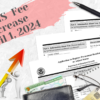When USCIS (United States Citizenship and Immigration Services) first announced the proposed fee increases on May 4, 2016, I got to examine the recommended fee schedule. I wasn’t surprised at this, considering the last substantial fee increase was in 2007 where fees went up 66 percent. (In 2010 fees also went up but only by 10 percent). Since that announcement I’ve seen a lot of propaganda about dramatic fee increases, mainly from websites advertising do it yourself style immigration form services. The line goes something like this: File your immigration case now before fees go up 80 percent! Well, turns out that the average fee increase proposed this time is actually 21 percent.
So, how do they make these advertising claims? The way they get around it is by stating the increase only for the forms that are going up substantially, even though most of these are applications that the average person will never submit.
The largest increase being proposed is in the EB-5 forms which is for foreign citizens who have $500,000 to $1 million to invest in a U.S. enterprise in exchange for a green card. Under this program, the fee for form I-924, Application for Regional Center, is currently $6,230 and is proposed to go up to $17,795. How’s that for a whopping increase? But the players involved in this EB-5 program can certainly afford it, so it’s hard to feel sorry for them.
What I am more concerned with is the fact that USCIS is proposing fee increases, yet their customer service is lacking, particularly when it comes to the timely processing of applications. AILA (American Immigration Lawyers Association) recently submitted comments to USCIS expressing concerns over this and a number of other issues. I will briefly highlight the main points that AILA has addressed in their letter to USCIS:
Processing times for many applications are at an unprecedented high.
Some of the worst offenders here are applications for work permits (I-765), renewals of DACA (I-821-D Deferred Action for Childhood Arrivals), and petitions for victims of crimes (I-918). The people that are filing these applications can be delayed in being able to work, go to college, or get a driver’s license. It should be in the interest of the government to adjudicate these cases quickly. Now USCIS wants to make people pay more to file the application, yet continue to provide slow service?
No plans to increase Premium Processing for certain applications.
Some immigration applications allow premium processing – by paying an extra $1225 with form I-907, your application is guaranteed to be processed within 15 days. But at this time, only certain forms are eligible. Many of these are business and investor applications, but it’s a great way for USCIS to generate extra income. Why not consider extending this service to some other types of applications? Makes sense, but at this time we are told that USCIS has no plans to do so.
USCIS should stop collecting fees through unannounced policy changes.
It doesn’t seem right if one day fees are one amount, and the next day an unannounced policy change results in having to pay more fees. That’s exactly what is going on with Naturalization applicants who are being told they must file for a green card renewal (form I-90) just to get a travel stamp in their passport if their green card has expired. The rule was that if your green card is valid for at least 6 months at the time of filing your naturalization application, and your green card expires while you are waiting for your naturalization to be approved, all you had to do was go to your local USCIS office to get a travel stamp in your valid passport as proof of your permanent residence status. It doesn’t even make sense to file the I-90 while the naturalization is pending, because in many cases the I-90 takes longer to approve than naturalization, thus making the I-90 completely useless in the scenario just described.
Some fee increases seem excessive, given the minimal work required for processing.
Shouldn’t there be some correlation between the amount of work done to process immigration applications and the fee charged? If so, then why is the application for travel document (form I-131) proposed to go up by 60 percent? In many cases, the approval for this form is based on having another underlying application pending, such as when permanent residence is filed, the travel document is soon approved. The I-90 green card renewal is a form that is just for a replacement card, yet this application is going up 25%. The degree of proposed fee increase does not appear to correlate with the amount of analysis and investigation involved for the application.
Make employment authorization and travel documents valid longer, to avoid replacement costs.
Because some immigration applications take so long to process, when the employment authorization and travel document card is issued for one year while the underlying immigration benefit is pending, this may result in the need to apply for a replacement employment authorization card when it expires before the benefit has been granted. If there is a strong likelihood that the underlying application may take longer than one year to get approved, why not issue the employment card for 18 months or two years to build in some extra time and avoid so many renewals?
Expand electronic filing to more applications.
Did the technology boom pass right by USCIS? Why are so few applications being processed electronically? They seem to be living in a different era, where paper forms with original signatures still need to be mailed to the processing center and requests for further evidence from USCIS get mailed back to the applicant. Only the I-90 green card renewal form can be filed completely online with USCIS. It works great – you sign the application online by agreeing that you approve the content of the application, you upload your scans of original documents, and you never have to mail a thing. (But USCIS still sends you the receipt and request for fingerprints in the mail, which kind of defeats the purpose of electronic filing!) Why not roll this out to other applications? Naturalization would be a logical next step.
There is some good news being proposed by USCIS: A tiered fee structure for Naturalization.
At this time it costs $680 (including $85 for fingerprints) to file the N-400 Naturalization form to get U.S. citizenship. USCIS is proposing this fee go up to $725, but for those with low household incomes (greater than 150% and not more than 200% of the Federal Poverty guidelines), a reduced fee of $405 would be charged. Yeah! Finally a fee decrease for those who need it most. This should encourage more lawful permanent residents to apply for citizenship and obtain the benefits that go along with it like being able to vote and travel out of the country for longer periods of time.
The public had until July 5, 2016 to comment on the USCIS proposal to increase the filing fees. AILA has submitted the above comments plus more and hopefully some will be considered.
If you know that you will be filing an immigration case this year, it would be in your interest to do it before October/November as that is generally when USCIS fees go up. Stay tuned for the results now that the comment period has ended. Hopefully there will be some improvements in the application turnaround to match the increased fees!









